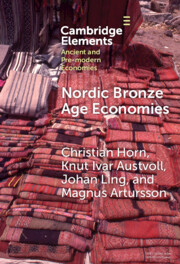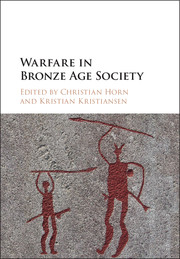24 results
‘Everything In Its Right Place’—Selective Depositions in Bronze Age Southwest Sweden
-
- Journal:
- Cambridge Archaeological Journal , First View
- Published online by Cambridge University Press:
- 22 April 2024, pp. 1-20
-
- Article
-
- You have access
- Open access
- HTML
- Export citation

Nordic Bronze Age Economies
- Coming soon
-
- Expected online publication date:
- March 2024
- Print publication:
- 31 May 2024
-
- Element
- Export citation
Water and the Afterlife – Water-related Resources in the Burial Construction of the Nordic Bronze Age
-
- Journal:
- Proceedings of the Prehistoric Society , First View
- Published online by Cambridge University Press:
- 11 March 2024, pp. 1-21
-
- Article
-
- You have access
- Open access
- HTML
- Export citation
Archaeologists just wanna have fun
-
- Journal:
- Archaeological Dialogues / Volume 30 / Issue 1 / June 2023
- Published online by Cambridge University Press:
- 21 June 2023, pp. 17-20
-
- Article
-
- You have access
- Open access
- HTML
- Export citation
Multiple datasets confirm range extension of the sicklefin devil ray Mobula tarapacana in the western North Atlantic Ocean off the eastern USA
-
- Journal:
- Journal of the Marine Biological Association of the United Kingdom / Volume 103 / 2023
- Published online by Cambridge University Press:
- 24 April 2023, e30
-
- Article
- Export citation
Warriors as a Challenge: Violence, Rock Art, and the Preservation of Social Cohesion During the Nordic Bronze Age
-
- Journal:
- European Journal of Archaeology / Volume 26 / Issue 1 / February 2023
- Published online by Cambridge University Press:
- 03 August 2022, pp. 57-80
- Print publication:
- February 2023
-
- Article
-
- You have access
- Open access
- HTML
- Export citation
5 - Weapons, Warriors and Warfare in Bronze Age Europe
- from Part I - The Origins of Conflict
-
-
- Book:
- The Cambridge World History of Violence
- Published online:
- 13 March 2020
- Print publication:
- 26 March 2020, pp 117-141
-
- Chapter
- Export citation
Andrew Reinhard. Archaeogaming: An Introduction to Archaeology in and of Video Games (New York & Oxford: Berghahn, 2018, 236pp., 22 illustr., pbk, ISBN 978-1-78533-873-1)
-
- Journal:
- European Journal of Archaeology / Volume 22 / Issue 4 / November 2019
- Published online by Cambridge University Press:
- 08 November 2019, pp. 612-616
- Print publication:
- November 2019
-
- Article
- Export citation
Contributors
-
- Book:
- Warfare in Bronze Age Society
- Published online:
- 06 April 2018
- Print publication:
- 26 April 2018, pp vii-viii
-
- Chapter
- Export citation
Index
-
- Book:
- Warfare in Bronze Age Society
- Published online:
- 06 April 2018
- Print publication:
- 26 April 2018, pp 244-254
-
- Chapter
- Export citation
Contents
-
- Book:
- Warfare in Bronze Age Society
- Published online:
- 06 April 2018
- Print publication:
- 26 April 2018, pp v-vi
-
- Chapter
- Export citation
Chapter One - Introducing Bronze Age Warfare
-
-
- Book:
- Warfare in Bronze Age Society
- Published online:
- 06 April 2018
- Print publication:
- 26 April 2018, pp 1-15
-
- Chapter
-
- You have access
- HTML
- Export citation
Preface
-
- Book:
- Warfare in Bronze Age Society
- Published online:
- 06 April 2018
- Print publication:
- 26 April 2018, pp ix-x
-
- Chapter
- Export citation
Copyright page
-
- Book:
- Warfare in Bronze Age Society
- Published online:
- 06 April 2018
- Print publication:
- 26 April 2018, pp iv-iv
-
- Chapter
- Export citation
Chapter Four - Warfare vs. Exchange? Thoughts on an Integrative Approach
-
-
- Book:
- Warfare in Bronze Age Society
- Published online:
- 06 April 2018
- Print publication:
- 26 April 2018, pp 47-60
-
- Chapter
- Export citation
Harald Meller, Hans Peter Hahn, Reinhard Jung and Roberto Risch, eds. Arm und Reich — Zur Ressourcenverteilung in prähistorischen Gesellschaften / Rich and Poor — Competing for Resources in Prehistoric Societies. 8. Mitteldeutscher Archäologentag vom 22. bis 24. Oktober 2015 in Halle (Saale) / 8th Archaeological Conference of Central Germany, October 22‒24, 2015 in Halle (Tagungen des Landesmuseums für Vorgeschichte Halle 14/I‒14/II. Halle: Landesamt für Denkmalpflege und Archäologie Sachsen-Anhalt, Landesmuseum für Vorgeschichte, 2016, 651pp., numerous b/w and colour illustr., hbk, ISBN 978-3-944507-45-3)
-
- Journal:
- European Journal of Archaeology / Volume 21 / Issue 2 / May 2018
- Published online by Cambridge University Press:
- 23 April 2018, pp. 313-317
- Print publication:
- May 2018
-
- Article
- Export citation

Warfare in Bronze Age Society
-
- Published online:
- 06 April 2018
- Print publication:
- 26 April 2018
Transforming the Rocks – Time and Rock Art in Bohuslän, Sweden
-
- Journal:
- European Journal of Archaeology / Volume 21 / Issue 3 / August 2018
- Published online by Cambridge University Press:
- 11 August 2017, pp. 361-384
- Print publication:
- August 2018
-
- Article
- Export citation
Dietary flavanol intervention lowers the levels of endothelial microparticles in coronary artery disease patients
-
- Journal:
- British Journal of Nutrition / Volume 111 / Issue 7 / 14 April 2014
- Published online by Cambridge University Press:
- 29 November 2013, pp. 1245-1252
- Print publication:
- 14 April 2014
-
- Article
-
- You have access
- HTML
- Export citation



